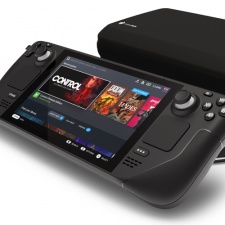Valve shocked the industry back in July last year with the announcement of its upcoming portable gaming PC, the Steam Deck. With its upcoming release now this week - February 25th 2022 - bumped a couple of months from its original launch date of December last year - what do we know about the Steam Deck - and can it succeed where its competitors failed to gain traction?
What is the Steam Deck?
The Steam Deck is a handheld gaming pc that enables users to play games from their Steam library on the go.
PC giant Valve has revealed how it is judging which games will work on its Steam Deck console. On its website, the firm says that there are four tiers of compatibility for games with the upcoming hardware. 'Verified' titles will work fine on Steam Deck right off the bat, while 'Playable' games might require users to mess around in the settings for a little while. 'Unsupported' titles don't work on Steam Deck, while 'Unknown' simply means that Valve hasn't checked how it runs on the console yet.
For a game to be Deck Verified, it needs to have full controller support, have no compatibility warning, boast a default resolution of 1280x800 or 1280x720 and should run on the Proton software.
There are some games that, while they may be great on a desktop PC, aren't a great experience on Steam Deck.Valve Software
"With Steam Deck, we're bringing your Steam Library to a new form factor—a portable gaming PC," Valve wrote. "While many games run great on Deck out of the box, this shift means there are some games that, while they may be great on a desktop PC, aren't a great experience on Steam Deck.
"We want it to be easy for you to find great gaming experiences on Steam Deck, so we’ve designed a system to do just that."
Note that some titles will not be supported by the gaming PC - emphasis on 'gaming PC'. This is not a console. Users can plug their Steam Deck into a monitor, stream video and install apps and software (including other online stores, according to Valve). Users will be able to download other games services such as GoG and Battle.Net.
A handheld device that behaves like a PC sets the Steam Deck apart from its obvious console comparison, the Nintendo Switch - more on that later - but does Valve's upcoming portable PC have the power to play existing games?
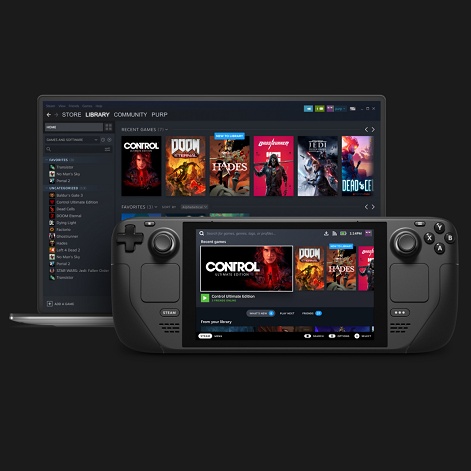
For those used to playing the Switch, the Steam Deck's display will feel a little bigger.
The specs
The Steam Deck is fitted with a 7-inch LCD touchscreen that has a refresh rate of 60Hz and 1280 x 800 Resolution. That 7-inch display might sound a little small but for those used to playing the Switch in handheld mode, the Steam Deck's display will feel a little bigger (by 0.8 inches to be specific).
Running on an AMD APU, the chip is built around two AMD architectures; RDNA 2 and Zen 2. Four Zen 2 cores can be found within the Steam Deck, capable of eight threads. Zen 2 cores can be found in the third generation of Ryzen processors such as the Ryzen 3000.
As for the RDNA 2, it’s responsible for the Steam Deck's graphical capabilities. With eight compute units (CUs) stuck behind that 7-inch touchscreen, this handheld won’t keep up with next-gen consoles. For comparison, the Xbox Series X comes packed with 12 more RDNA CUs. That being said, this is a handheld device and it should be able to run almost anything released for PC, albeit at a lower graphical quality.
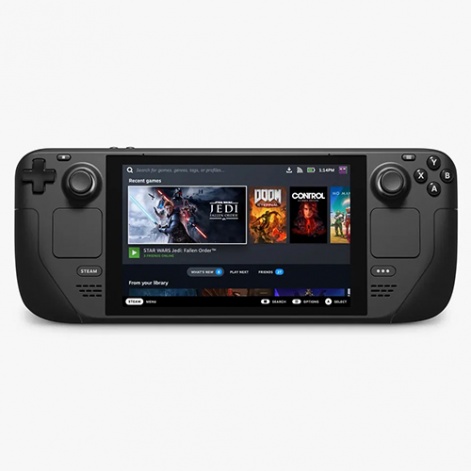
Price and release date
There are three different storage options, from the entry-level 64GB eMMC to the NVMe SSD based 256GB and 512GB variants. All of these options come with MicroSD card slots if gamers need to bump up their storage capacity.
These are the prices Valve have listed on the Steam Deck's store page:
- 64GB Steam Deck £349 ($399)
- 256GB Steam Deck £459 ($529)
- 512GB Steam Deck £569 ($649)
The Steam Deck store page now shows, "Expected order availability: After Q2 2022" for new customers that have not pre-ordered. Valve recently reassured customers that their handheld is on track for the advertised release date in a ‘January Update’ blog post.
Orders can be placed from the United States, Canada, the European Union and the United Kingdom now.
Steam Deck alternatives
All of these systems have pros and cons - a consumer could justify any of them, depending on their requirements. One thing that more budget-conscious gamers may want to keep in mind is affordability, because even the bottom-of-the-line versions of these handhelds are more pricey than even the highest-end Steam Deck.
GPD Win 3 (From $999)
Released last year, the GPD Win 3 offers some healthy competition for Valve. With 1TB of storage coming as standard, memory is not as much of an issue with this handheld gaming PC. Housing a full QWERTY keyboard behind the movable screen - as well as traditional controller inputs - the GPD Win 3 offers more versatility when it comes to playing games built with PC in mind. However, with a 5.5-inch 720p display, if graphical prowess is a sticking point, the GPD Win 3 will more than likely run triple-A titles on lower graphics settings.
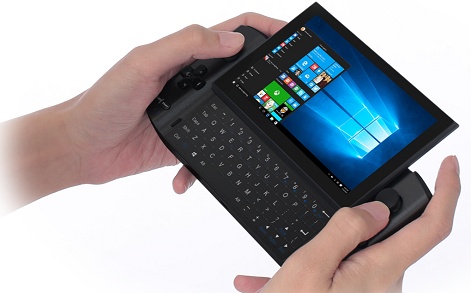
OnexPlayer (From $1059)
On the more premium side of handheld PC gaming, is the OnexPlayer. Boasting an 8.4-inch screen with a 2560 x 1600 IPS display, the OnexPlayer is capable of producing a commendable visual quality. If raw power is what gamers are looking for, this handheld offers just that. Capable of playing triple-A titles at 60fps at 1080p, this is the most technologically advanced handheld gaming pc on the market.
The OnexPlayer has been criticised for its less than stellar audio quality, but the 3.5mm audio jack paired with a decent pair of headphones can overcome this.
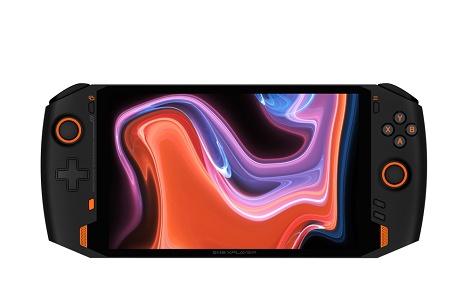
AYA Neo (From $925)
The AYA Neo was the world’s first 7-nanometre gaming handheld device, launching in March 2021. The onboard AMD APU takes responsibility for both processing and graphical output. Offering a 1Tb option, AYA Neo users will have more internal storage than their Steam Deck counterparts.
In terms of performance, this handheld may leave users wanting more. It can play the latest releases, however, this will be on the lowest graphical setting and sluggish frame rates. According to GBAtemp, this 720p console can play Cyberpunk 2077 on low graphical settings at 20fps.
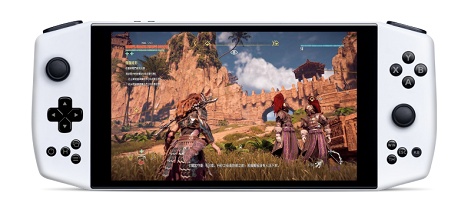
The Rabbid in the room
Nintendo has had the dedicated handheld gaming device sector all to itself in terms of big-name competitors for several years.
With the relative failure of Sony’s PlayStation Portable and Vita gaming-on-the-go systems, Nintendo has had the dedicated handheld gaming device sector all to itself in terms of big-name competitors for several years now. The sales reflect this as well, with Nintendo shifting over 89.04 million Switch consoles (according to Nintendo Life in August last year). But should Nintendo be worried about Valve throwing its hat into the ring?
Both Switch and Steam Deck feature the same versatile handheld/docked feature, but that just makes sense for a handheld in a post-Switch world. If a handheld system were to come out now without the ability to play it on the TV in your living room, it would feel somewhat behind the times.
As previously mentioned, the Steam Deck is NOT a games console, so we’d suggest that it's appealing to a different demographic. The Steam Deck could be considered the perfect gadget for a PC gamer who might not have the time or physical space in their home for full PC rig gaming.
Alternatively, the Switch is used by gamers for social play - party games, for instance. Its portability means gamers may carry them to their friends’ homes to play. That is where the Switch excels - bringing a group together with some same couch gaming.
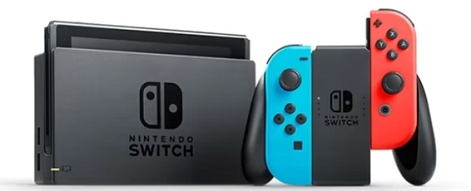
The takeaway (literally!)
Making PC gaming more accessible to the mainstream
The Steam Deck has the possibility of providing more options for the type of games typically seen on PC. This could afford game developers to craft experiences tailor-made to be played on-the-go, while making PC gaming more accessible to the mainstream.
As we’ve seen, despite the hugely popular Switch and Steam Deck appealing to different consumers, Valve’s new portable hardware is not without competition. With more systems with similar functionality on the market, Valve will have to ensure that its product stays ahead of the competition. Otherwise, this latest venture has the potential to become another Steam Machine - and we all know how that turned out...

